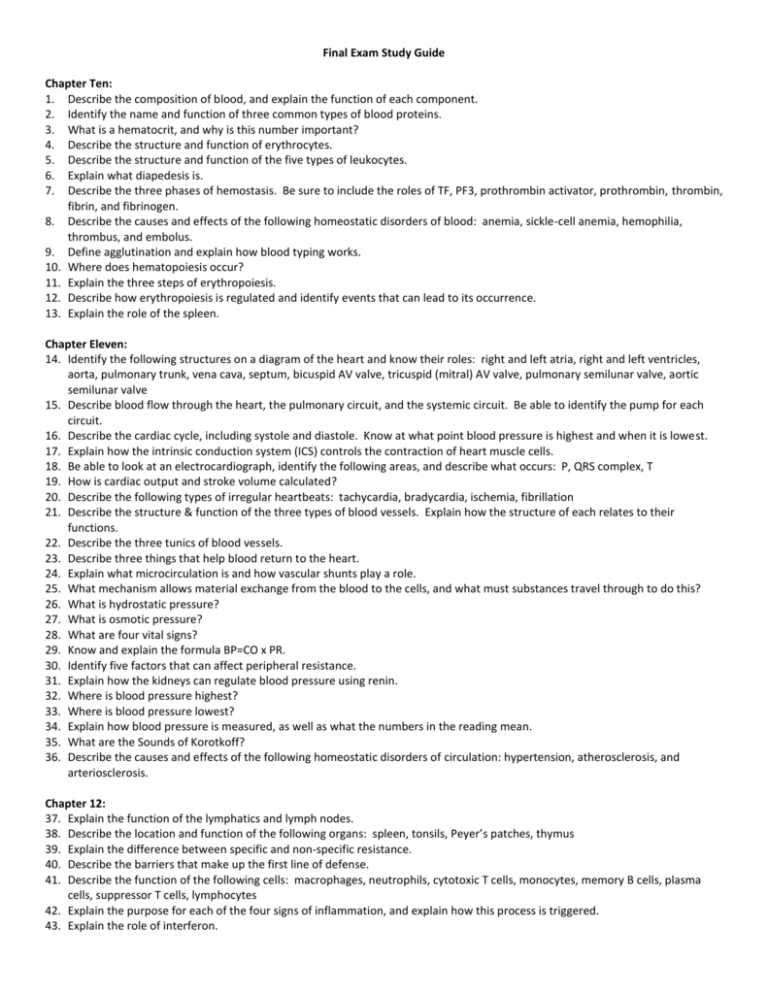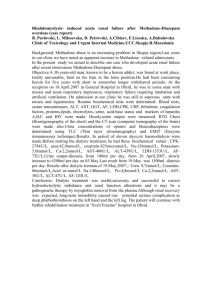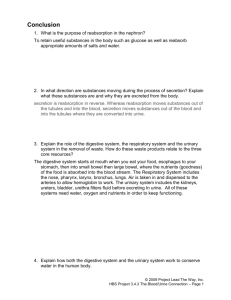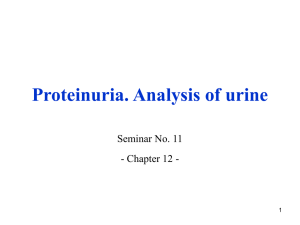Final Exam Study Guide
advertisement

Final Exam Study Guide Chapter Ten: 1. Describe the composition of blood, and explain the function of each component. 2. Identify the name and function of three common types of blood proteins. 3. What is a hematocrit, and why is this number important? 4. Describe the structure and function of erythrocytes. 5. Describe the structure and function of the five types of leukocytes. 6. Explain what diapedesis is. 7. Describe the three phases of hemostasis. Be sure to include the roles of TF, PF3, prothrombin activator, prothrombin, thrombin, fibrin, and fibrinogen. 8. Describe the causes and effects of the following homeostatic disorders of blood: anemia, sickle-cell anemia, hemophilia, thrombus, and embolus. 9. Define agglutination and explain how blood typing works. 10. Where does hematopoiesis occur? 11. Explain the three steps of erythropoiesis. 12. Describe how erythropoiesis is regulated and identify events that can lead to its occurrence. 13. Explain the role of the spleen. Chapter Eleven: 14. Identify the following structures on a diagram of the heart and know their roles: right and left atria, right and left ventricles, aorta, pulmonary trunk, vena cava, septum, bicuspid AV valve, tricuspid (mitral) AV valve, pulmonary semilunar valve, aortic semilunar valve 15. Describe blood flow through the heart, the pulmonary circuit, and the systemic circuit. Be able to identify the pump for each circuit. 16. Describe the cardiac cycle, including systole and diastole. Know at what point blood pressure is highest and when it is lowest. 17. Explain how the intrinsic conduction system (ICS) controls the contraction of heart muscle cells. 18. Be able to look at an electrocardiograph, identify the following areas, and describe what occurs: P, QRS complex, T 19. How is cardiac output and stroke volume calculated? 20. Describe the following types of irregular heartbeats: tachycardia, bradycardia, ischemia, fibrillation 21. Describe the structure & function of the three types of blood vessels. Explain how the structure of each relates to their functions. 22. Describe the three tunics of blood vessels. 23. Describe three things that help blood return to the heart. 24. Explain what microcirculation is and how vascular shunts play a role. 25. What mechanism allows material exchange from the blood to the cells, and what must substances travel through to do this? 26. What is hydrostatic pressure? 27. What is osmotic pressure? 28. What are four vital signs? 29. Know and explain the formula BP=CO x PR. 30. Identify five factors that can affect peripheral resistance. 31. Explain how the kidneys can regulate blood pressure using renin. 32. Where is blood pressure highest? 33. Where is blood pressure lowest? 34. Explain how blood pressure is measured, as well as what the numbers in the reading mean. 35. What are the Sounds of Korotkoff? 36. Describe the causes and effects of the following homeostatic disorders of circulation: hypertension, atherosclerosis, and arteriosclerosis. Chapter 12: 37. Explain the function of the lymphatics and lymph nodes. 38. Describe the location and function of the following organs: spleen, tonsils, Peyer’s patches, thymus 39. Explain the difference between specific and non-specific resistance. 40. Describe the barriers that make up the first line of defense. 41. Describe the function of the following cells: macrophages, neutrophils, cytotoxic T cells, monocytes, memory B cells, plasma cells, suppressor T cells, lymphocytes 42. Explain the purpose for each of the four signs of inflammation, and explain how this process is triggered. 43. Explain the role of interferon. 44. 45. 46. 47. 48. 49. 50. 51. 52. 53. 54. 55. 56. 57. 58. 59. 60. 61. Describe the complement system and explain how it functions. How is fever triggered, and how is it helpful? Explain the process of primary humoral response. Explain the process of secondary humoral response. Explain the process of cell-mediated immunity. Describe three types of antigens. What are immunoglobulins, and how do they work? How and where are B cells and T cells produced? How do vaccines work? Identify two types of active immunity and give examples of each. Identify two types of passive immunity and give examples of each. Identify six types of pathogens and provide a disease caused by each. Identify six ways diseases can be transmitted. Why aren’t viruses considered to be alive? How do viruses reproduce? Why don’t antibiotics work on viruses? What is antibiotic resistance? Why is HIV so good at getting past the immune system? Chapter 13: 62. Explain the function of the following structures, and be able to identify them on a diagram: external nares, nasal cavity, oral cavity, palate, pharynx, nasopharynx, oropharynx, laryngopharynx, larynx, thyroid cartilage, epiglottis, vocal cords, glottis, trachea, bronchi, bronchioles, alveoli, diaphragm. 63. Describe the passage of an inhaled air molecule from the nose to the blood stream. 64. How does the epiglottis prevent food from entering the lungs? 65. What is the cough reflex, and how can consciousness affect it? 66. Describe the function of the cilia that lines the trachea. 67. Explain the difference between the respiratory zone and the conduction zone. 68. Explain the importance of surfactant in breathing. 69. Describe the four events that together make up respiration. 70. Explain how the actions of the diaphragm and the external intercostals result in inspiration. 71. Explain how expiration occurs. 72. Describe six nonrespiratory air movements. 73. Define tidal volume, IRV, ERV, residual volume, vital capacity, and dead space volume. 74. Describe the two recognizable sounds that can be heard through a stethoscope during breathing. 75. Describe two ways oxygen is transported in the blood. 76. How is carbon dioxide carried in the blood? 77. Explain how diffusion regulates gas exchange. 78. What variable is the brain monitoring to determine if breathing rate should increase? 79. Describe four factors influencing respiratory rate and depth. 80. Describe the causes and effects of the following homeostatic disorders of respiration: bronchitis, emphysema, cystic fibrosis, asthma Chapter 14: 81. Describe the two divisions of the digestive system. 82. Be able to identify any organ of the digestive system on a diagram, as well as describe their function. 83. Identify the structure and function of the four layers of the GI tract. 84. What is the purpose of plica? 85. Describe six functions of the digestive system. 86. Explain how deglutition occurs. 87. Explain how peristalsis occurs. 88. What are mass movements and where do they occur? 89. What is mastication? 90. What is segmentation? 91. What are hydrolysis reactions, and what types of molecules do they break the major nutrient groups into? 92. Describe where the digestion of carbohydrates takes place, from start to finish, including the enzymes involved and the organs or cells that secrete them. 93. Describe where the digestion of proteins takes place, from start to finish, including the enzymes involved and the organs or cells that secrete them. 94. Describe where the digestion of lipids takes place, from start to finish, including the enzymes involved and the organs or cells that secrete them. 95. What is a bolus? 96. Describe the path food takes through the digestive system from ingestion to defecation. 97. Where are rugae found and what is there purpose? 98. Where are mucous neck cells found and what do they do? 99. Identify the two sphincters of the stomach. 100. What is chyme? 101. Where are villi and microvilli found and what is their purpose? 102. Name the three parts of the small intestine, and describe their functions. 103. What is the role of the hormones gastrin, secretin, and CCK? 104. Which molecules are absorbed by diffusion, and which require active transport? 105. Where are goblet cells found and what do they do? 106. How is defecation controlled? 107. Explain the cause of vomiting, heartburn, ulcers, flatulence, and diarrhea. 108. What is metabolism? 109. Explain the difference between anabolism and catabolism. 110. Explain what ATP and kilocalories are, as well as the relationship between them. 111. What are the three major nutrient groups? 112. What is the main role of vitamins in the body? 113. What are the major roles of the liver? 114. Explain the function of the liver as it relates to carbohydrates. 115. Explain the function of the liver as it relates to lipids. 116. Explain the function of the liver as it relates to proteins. 117. What types of foods are carbohydrates, and what organisms produce them? 118. How and where does carbohydrate metabolism take place? 119. How does the body produce ATP? 120. What types of foods are proteins? 121. What are essential amino acids? 122. What is a complete protein? What types of foods are typically complete proteins? 123. How and where are proteins used in the body? 124. How and where are lipids used in the body? 125. What is the importance of cholesterol in the body? 126. What is the difference between LDLs and HDLs? 127. Explain the importance of the HDL/LDL ratio, and how you can keep it desirable. 128. What is the basal metabolic rate, and what is the most important factor in determining it? 129. What is the total metabolic rate? 130. What amount of food energy is used to produce ATP? What happens to the rest? 131. What part of the body regulates body temperature, and how is this done? 132. When looking at a nutrition label, what is the first and most important piece of information you should consider and why? 133. What type of fat on the nutrition label is worst for you and why? 134. When looking at calorie levels, what is considered low, medium, and high amounts of calories? 135. What percentage of calories should come from fat (as a target level?) 136. When looking at nutrients you want in your food, what is considered low & high levels? Chapter 15: 137. Be able to describe the function of the following structures and identify them on a diagram: kidney, ureter, bladder, urethra, renal artery, renal vein, renal hilus, renal capsule, adipose capsule, calyces, renal pelvis, cortex, medulla, nephron, glomerulus, Bowman’s capsule, proximal convoluted tubule, loop of Henle, distal convoluted tubule, collecting duct, capillaries 138. Describe the process of urine formation, including where and how each substance is moved in and out of the filtrate. 139. Explain how the loop of Henle functions to concentrate urine. Be sure to know where concentration is highest and lowest. 140. How does urine move through the ureters? 141. Describe the process of micturition, as well as the roles of the bladder in the process. 142. How do ADH and aldosterone regulate urine content? Where are these hormones produced? 143. What are the characteristics of normal urine? 144. What might be found in urine that can signal diabetes? 145. What is the cause of urinary tract infections, and why is it more common in women than men? 146. What are kidney stones and what causes them? Chapter 16: 147. Identify the function of the following structures and be able to identify them on a diagram: seminiferous tubules, tunica albuginea, penis shaft, glans penis, prepuce, scrotum, epididymis, ductus deferens, urethra, seminal vesicles, prostate, bulbourethral gland, mons pubis, labia majora, labia, minora, vestibule, clitoris, ovaries, Fallopian tubes, fimbriae, uterus, cervix 148. Why are the testes external to the body? 149. How does an erection occur and what is the tissue called? 150. What is the function of Leydig cells? 151. What is the function of Sertoli cells? 152. Describe the process of spermatogenesis, including hormones involved, and the role of spermatogonium, primary spermatocytes, secondary spermatocytes, spermatids, and Sertoli cells. 153. Describe the process of spermiogenesis. 154. Describe the contents and characteristics of semen. 155. How does ejaculation occur? 156. Describe the structure of a sperm and the function of each part. 157. Describe the primary and secondary effects of testosterone. 158. Explain the process of oogenesis, including the hormones involved, the time of occurrence, and the roles of the follicle cells, antrum, Graafian follicle, oogonium, primary oocyte, secondary oocyte, polar bodies, and ovum. 159. Explain the hormonal control of the menstrual cycle. 160. Describe the main events and time periods of the three phases of the uterine cycle. 161. Describe the main events and time periods of the three phases of the ovarian cycle. 162. Describe the main effects of estrogen and progesterone. 163. How a long a period of time is a person fertile for? 164. Identify several methods of birth control, how they work, how well they work, and whether they prevent STD’s. 165. Describe the location and events leading to fertilization. Include the role of the acrosome, when an ovum forms, and when a zygote forms. 166. Explain what a morula is and how it forms. 167. Explain what a blastula is, and tell what the fate of the inner cell mass and the trophoblast are. 168. What does HCG do, where is it secreted from, and why do we test for it? 169. What is the role of the placenta, and how does it form? 170. Describe the process of gastrulation, and tell what each of the three primary germ layers will form in the embryo. 171. Explain the difference between a zygote, and embryo, and a fetus. 172. Summarize the main events of each trimester of pregnancy. 173. Why are miscarriages most likely to occur during the first trimester? 174. The first trimester the time when birth defects due to harmful substances the mother takes in are most likely to occur. Why? 175. Explain the three stages of parturition, including the meaning of the terms dilation and effacement. 176. Explain the positive hormonal feedback loop that results in childbirth. 177. Describe the roles of oxytocin after delivery.









